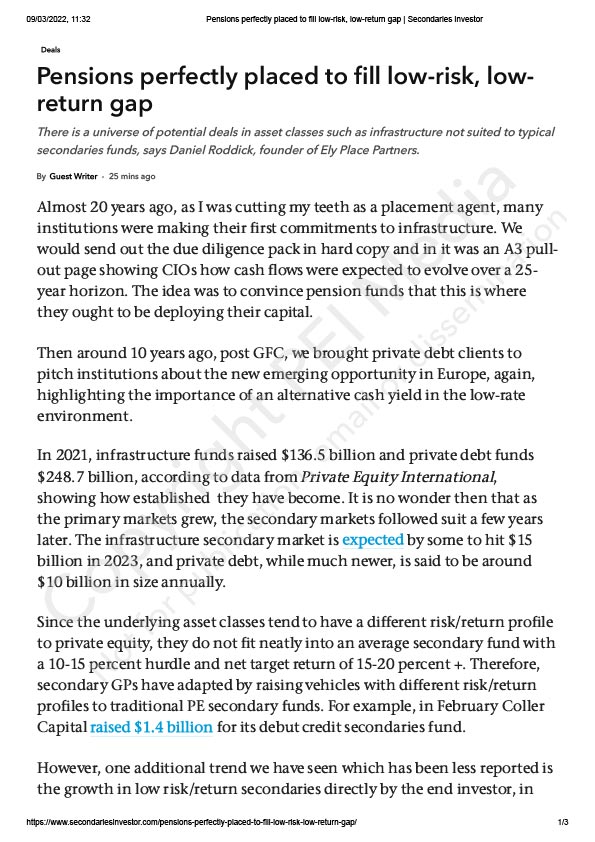Pensions perfectly placed to fill low-risk, low-return gap
Secondaries Investor
As a guest writer
09 March 2022
Pensions perfectly placed to fill the low-risk, low-return gap.
There is a universe of potential deals in asset classes such as infrastructure not suited to typical secondaries funds, says Daniel Roddick, founder of Ely Place Partners.
Almost 20 years ago, as I was cutting my teeth as a placement agent, many institutions were making their first commitments to infrastructure. We would send out the due diligence pack in hard copy and in it was an A3 pullout page showing CIOs how cash flows were expected to evolve over a 25-year horizon. The idea was to convince pension funds that this is where they ought to be deploying their capital.
Then around 10 years ago, post-GFC, we brought private debt clients to pitch institutions about the new emerging opportunity in Europe, again, highlighting the importance of an alternative cash yield in the low-rate environment.
In 2021, infrastructure funds raised $136.5 billion and private debt funds $248.7 billion, according to data from Private Equity International, showing how established they have become. It is no wonder then that as the primary markets grew, the secondary markets followed suit a few years later. The infrastructure secondary market is expected by some to hit $15 billion in 2023, and private debt, while much newer, is said to be around $10 billion in size annually.
Since the underlying asset classes tend to have a different risk/return profile to private equity, they do not fit neatly into an average secondary fund with a 10-15 per cent hurdle and a net target return of 15-20 percent+. Therefore, secondary GPs have adapted by raising vehicles with different risk/return profiles to traditional PE secondary funds. For example, in February Coller Capital raised $1.4 billion for its debut credit secondaries fund.
However, one additional trend we have seen which has been less reported is the growth in low-risk/return secondaries directly by the end investor, in particular pension funds.
While the growth in the lower cost of capital vehicles managed by secondary players makes perfect sense, if they are set up as traditional co-mingled funds charging fees and carry, then they will still need to achieve a certain return threshold to cover their own economics. And depending on the remaining term of the secondary fund, the longer-term nature of many infrastructure deals can make them an imperfect fit.
Our experience with a recent transaction (see below) was that there is now a growing pension-led secondary universe that is perfectly positioned to take advantage of these lower-risk, long-term secondaries that do not fit the mould for most buyers. The trends we have seen include pension funds developing in-house capabilities to execute secondary transactions, specialist secondary advisers partnering with pension funds to create targeted SMAs, income funds set up by pension advisers, and in the UK, the ‘pooling’ of local authorities giving them the means to undertake more complex transactions and at scale.
We have come far in the past 20 years. Long gone are the days when pension funds needed convincing about the merits of infrastructure – today they are leading the charge, providing liquidity where others cannot and capitalising on a growing market where they are uniquely positioned. I think we will see a lot more over the next 20 years.
London LGPS acquisition of LP position in BlackRock Renewable Income UK Fund.
In 2021, Ely Place acted as adviser to a seller in a £107 million secondary sale of a single fund position in BlackRock Renewable Income UK Fund (“BRIUK”) to funds managed by London LGPS CIV Ltd (“London CIV”), a company that manages UK Local Government Pension Scheme (“LGPS”) assets.
BRIUK is a renewables infrastructure fund managed by BlackRock and invested in a diverse portfolio of 48 wind and solar projects across the UK. The Global Renewable Power platform has invested directly in over 300 projects globally, including onshore wind, offshore wind and solar photovoltaic projects.
Established in 2015 as one of eight LGPS asset pooling companies, London CIV manages more than £11.2 billion of assets. The single fund position in BRIUK was the first secondary transaction in the LCIV Renewable Infrastructure Fund, which was established by London CIV to invest in renewable infrastructure funds with a focus on renewable energy infrastructure assets.



